The Intel Optane Memory H10 Review: QLC and Optane In One SSD
by Billy Tallis on April 22, 2019 11:50 AM ESTAnandTech Storage Bench - Light
Our Light storage test has relatively more sequential accesses and lower queue depths than The Destroyer or the Heavy test, and it's by far the shortest test overall. It's based largely on applications that aren't highly dependent on storage performance, so this is a test more of application launch times and file load times. This test can be seen as the sum of all the little delays in daily usage, but with the idle times trimmed to 25ms it takes less than half an hour to run. Details of the Light test can be found here. As with the ATSB Heavy test, this test is run with the drive both freshly erased and empty, and after filling the drive with sequential writes.

The Intel Optane Memory H10 is generally competitive with other low-end NVMe drives when the Light test is run on an empty drive, though the higher performance of the QLC portion on its own indicates that the H10's score is probably artificially lowered by starting with a cold Optane cache. The full-drive performance is worse than almost all of the TLC-based SSDs, but is still significantly better than a hard drive without any Optane cache.

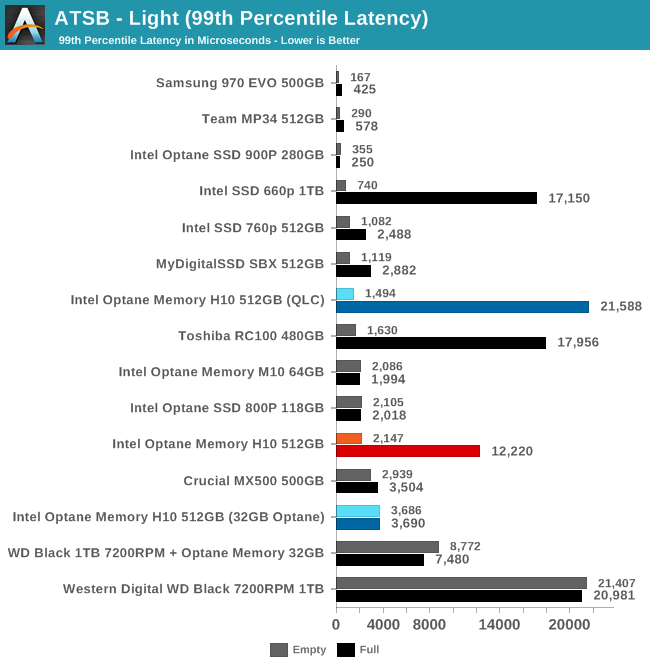
The average and 99th percentile latencies from the Optane Memory H10 are competitive with TLC NAND when the test is run on an empty drive, and even with a full drive the latency scores remain better than a mechanical hard drive.
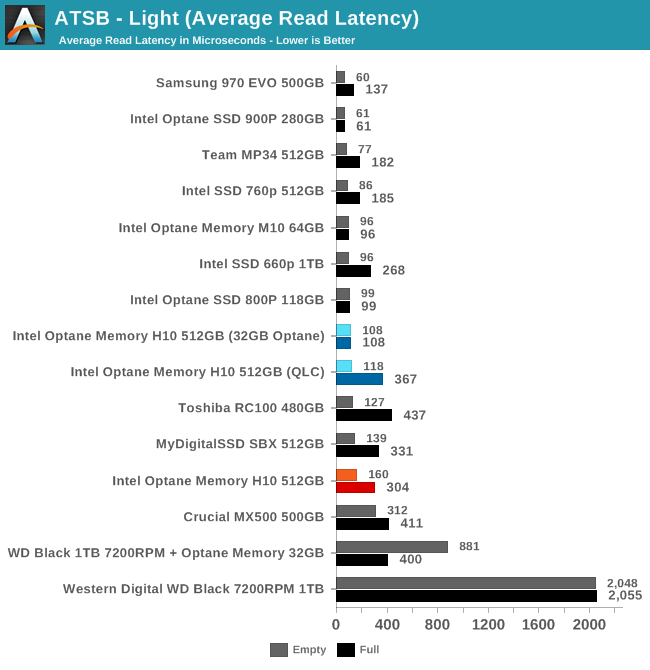
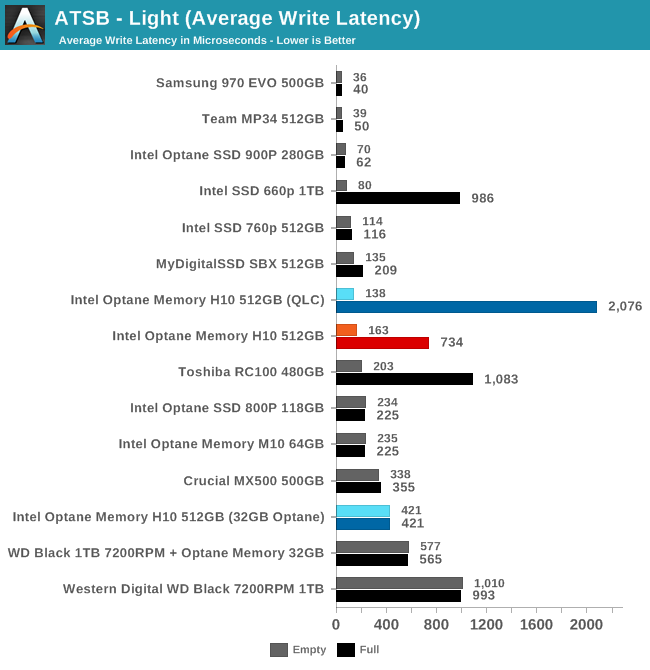
The average write latency in the full-drive run is the only thing that sticks out and identifies the H10 as clearly different than other entry-level NVMe drives, but the TLC-based DRAMless Toshiba RC100 is even worse in that scenario.
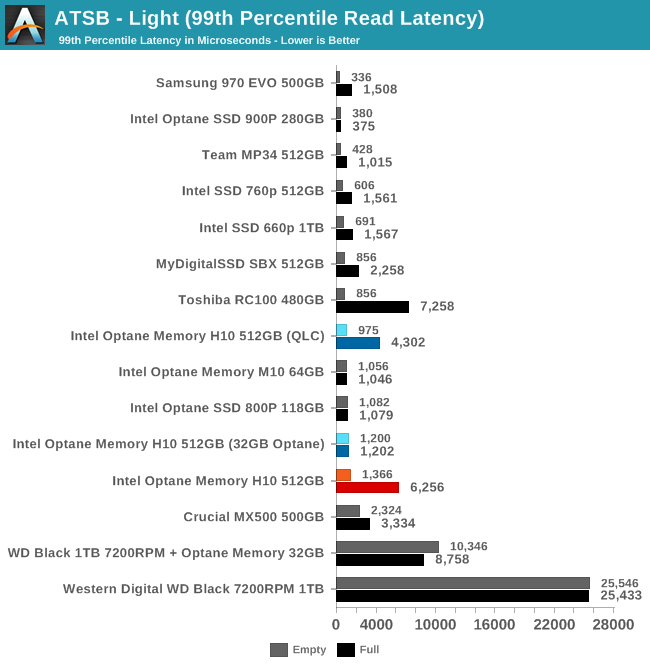
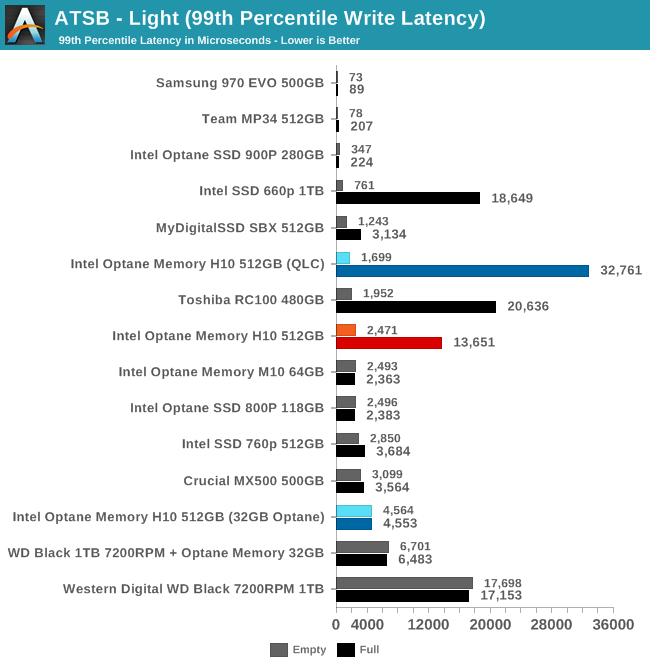
Unlike the average latencies, both the read and write 99th percentile latency scores for the Optane H10 show that it struggles greatly when full. The Optane cache is not nearly enough to make up for running out of SLC cache.










60 Comments
View All Comments
yankeeDDL - Monday, April 22, 2019 - link
Is it me or, generally speaking, it is noticeably slower than the 970 Evo?DanNeely - Monday, April 22, 2019 - link
The 970 can make use of 4 lanes, with only 2 effective lanes in most scenarios any good x4 drive is going to be able to smoke the H10.yankeeDDL - Monday, April 22, 2019 - link
I still remember that Optane should be 1000x faster and 1000x cheaper. It seems that it is faster, albeit by a much lower factor ... then why hamper it with a slower bus? I mean, I came to read the review thinking that it could be a nice upgrade, and then I see it beaten handily by the 970 Evo. What's the point of such device? It is clearly more complex, so I doubt it'll be cheaper than the 970 Evo...Alexvrb - Monday, April 22, 2019 - link
Wait, did they say it would be cheaper? I don't remember that. I know they thought it would be a lot faster than it is... to be fair they seemed to be making projections like NAND based solutions wouldn't speed up at all in years LOL.It can be a lot faster in certain configs (the high end PCIe add-on cards, for example) but it's insanely expensive. Even then it's mainly faster for low QDs...
kgardas - Tuesday, April 23, 2019 - link
Yes, but just in comparison with DRAM prices. E.g. NVDIMM of big size cheaper than DIMM of big size.Irata - Tuesday, April 23, 2019 - link
It was supposed to be 1000x faster and have 1000x the endurance of NAND as per Intel's official 2016 slides.It may be slightly off on those promises - would have loved for the article to include the slide with Intel's original claims.
Price wasn't mentioned.
yankeeDDL - Tuesday, April 23, 2019 - link
You're right. They said 1000x faster, 1000x endurance and 10x denser, but they did not say cheaper, although, the 10x denser somewhat implies it (https://www.micron.com/~/media/documents/products/... Still, this drive is not faster, nor it has significantly higher endurance. Let's see if it is any cheaper.Valantar - Tuesday, April 23, 2019 - link
Denser than DRAM, not NAND. Speed claims are against NAND, price/density claims against DRAM - where they might not be 1/10th the price, but definitely cheaper. The entire argument for 3D Xpoint is "faster than NAND, cheaper than DRAM (while persistent and closer to the former than the latter in capacity)", after all.CheapSushi - Wednesday, April 24, 2019 - link
I think this is why there's still negative impressions around 3D Xpoint. Too many people still don't understand it or confuse the information given.cb88 - Friday, May 17, 2019 - link
Optane itself is *vastly* faster than this... on an NVDIMM it rivals DDR4 with latencies in hundreds of ns instead of micro or milliseconds. And bandwidth basically on par with DDR4.I think it's some marketing BS that they don't use 4x PCIe on thier M.2 cards .... perhaps trying to avoid server guys buying them up cheap and putting them on quad m.2 to PCIe adapters.